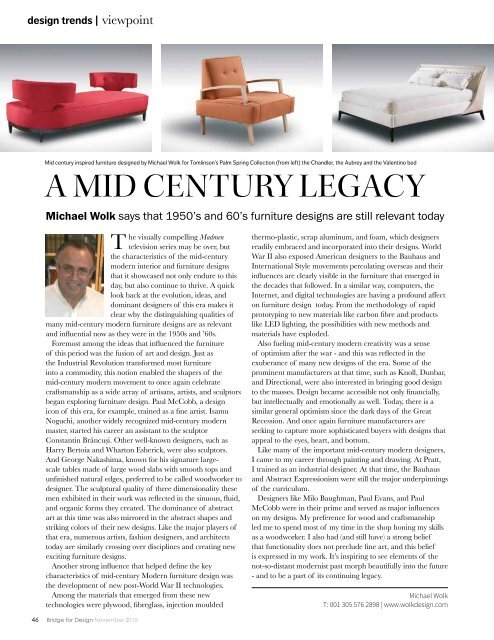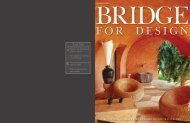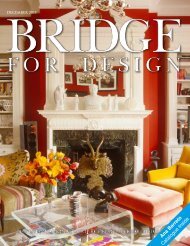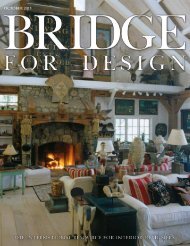Bridge For Design November Issue
Inside the November issue we have the latest from the world of interior design. We look around the Candy Brothers’ luxury penthouse in Monte Carlo. We explore the colourful home of Liza Bruce and Nicholas Alvis Vega in India. We hear about the culture shock when Anne-Marie Midy and Jorge Almada moved from Mexico to Belgium. Design projects by Axis Mundi in New York, Phillip Silver in San Francisco and Coffinier Ku Design in Soho. Other designers included in our November issue; Laura Hammett, Robert Angell, Michael Wolk, Fiona Kelly, Sera Hersham-Loftus, Roger Oates and more. Also included is the brand new Love & Light catalogue, a company well known for their beautifully designed, hand painted and handcrafted lamps and shades.
Inside the November issue we have the latest from the world of interior design. We look around the Candy Brothers’ luxury penthouse in Monte Carlo. We explore the colourful home of Liza Bruce and Nicholas Alvis Vega in India. We hear about the culture shock when Anne-Marie Midy and Jorge Almada moved from Mexico to Belgium. Design projects by Axis Mundi in New York, Phillip Silver in San Francisco and Coffinier Ku Design in Soho. Other designers included in our November issue; Laura Hammett, Robert Angell, Michael Wolk, Fiona Kelly, Sera Hersham-Loftus, Roger Oates and more. Also included is the brand new Love & Light catalogue, a company well known for their beautifully designed, hand painted and handcrafted lamps and shades.
Create successful ePaper yourself
Turn your PDF publications into a flip-book with our unique Google optimized e-Paper software.
design trends | viewpoint<br />
Mid century inspired furniture designed by Michael Wolk for Tomlinson’s Palm Spring Collection (from left) the Chandler, the Aubrey and the Valentino bed<br />
A MID CENTURY LEGACY<br />
Michael Wolk says that 1950’s and 60’s furniture designs are still relevant today<br />
T<br />
he visually compelling Madmen<br />
television series may be over, but<br />
the characteristics of the mid-century<br />
modern interior and furniture designs<br />
that it showcased not only endure to this<br />
day, but also continue to thrive. A quick<br />
look back at the evolution, ideas, and<br />
dominant designers of this era makes it<br />
clear why the distinguishing qualities of<br />
many mid-century modern furniture designs are as relevant<br />
and influential now as they were in the 1950s and ’60s.<br />
<strong>For</strong>emost among the ideas that influenced the furniture<br />
of this period was the fusion of art and design. Just as<br />
the Industrial Revolution transformed most furniture<br />
into a commodity, this notion enabled the shapers of the<br />
mid-century modern movement to once again celebrate<br />
craftsmanship as a wide array of artisans, artists, and sculptors<br />
began exploring furniture design. Paul McCobb, a design<br />
icon of this era, for example, trained as a fine artist. Isamu<br />
Noguchi, another widely recognized mid-century modern<br />
master, started his career an assistant to the sculptor<br />
Constantin Brâncuși. Other well-known designers, such as<br />
Harry Bertoia and Wharton Esherick, were also sculptors.<br />
And George Nakashima, known for his signature largescale<br />
tables made of large wood slabs with smooth tops and<br />
unfinished natural edges, preferred to be called woodworker to<br />
designer. The sculptural quality of three dimensionality these<br />
men exhibited in their work was reflected in the sinuous, fluid,<br />
and organic forms they created. The dominance of abstract<br />
art at this time was also mirrored in the abstract shapes and<br />
striking colors of their new designs. Like the major players of<br />
that era, numerous artists, fashion designers, and architects<br />
today are similarly crossing over disciplines and creating new<br />
exciting furniture designs.<br />
Another strong influence that helped define the key<br />
characteristics of mid-century Modern furniture design was<br />
the development of new post-World War II technologies.<br />
Among the materials that emerged from these new<br />
technologies were plywood, fibreglass, injection moulded<br />
46 <strong>Bridge</strong> for <strong>Design</strong> <strong>November</strong> 2015<br />
thermo-plastic, scrap aluminum, and foam, which designers<br />
readily embraced and incorporated into their designs. World<br />
War II also exposed American designers to the Bauhaus and<br />
International Style movements percolating overseas and their<br />
influences are clearly visible in the furniture that emerged in<br />
the decades that followed. In a similar way, computers, the<br />
Internet, and digital technologies are having a profound affect<br />
on furniture design today. From the methodology of rapid<br />
prototyping to new materials like carbon fibre and products<br />
like LED lighting, the possibilities with new methods and<br />
materials have exploded.<br />
Also fueling mid-century modern creativity was a sense<br />
of optimism after the war - and this was reflected in the<br />
exuberance of many new designs of the era. Some of the<br />
prominent manufacturers at that time, such as Knoll, Dunbar,<br />
and Directional, were also interested in bringing good design<br />
to the masses. <strong>Design</strong> became accessible not only financially,<br />
but intellectually and emotionally as well. Today, there is a<br />
similar general optimism since the dark days of the Great<br />
Recession. And once again furniture manufacturers are<br />
seeking to capture more sophisticated buyers with designs that<br />
appeal to the eyes, heart, and bottom.<br />
Like many of the important mid-century modern designers,<br />
I came to my career through painting and drawing. At Pratt,<br />
I trained as an industrial designer. At that time, the Bauhaus<br />
and Abstract Expressionism were still the major underpinnings<br />
of the curriculum.<br />
<strong>Design</strong>ers like Milo Baughman, Paul Evans, and Paul<br />
McCobb were in their prime and served as major influences<br />
on my designs. My preference for wood and craftsmanship<br />
led me to spend most of my time in the shop honing my skills<br />
as a woodworker. I also had (and still have) a strong belief<br />
that functionality does not preclude fine art, and this belief<br />
is expressed in my work. It’s inspiring to see elements of the<br />
not-so-distant modernist past morph beautifully into the future<br />
- and to be a part of its continuing legacy.<br />
Michael Wolk<br />
T: 001 305 576 2898 | www.wolkdesign.com






